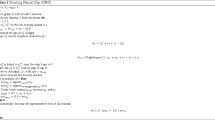Abstract
The ability to reveal the relevant patterns in an intuitively attractive way through incremental learning makes self-adaptive neural networks (SANNs) a power tool to support pattern discovery and visualisation. Based on the combination of the information related to both the shape and magnitude of the data, this paper introduces a SANN, which implements new similarity matching criteria and error accumulation strategies for network growth. It was tested on two datasets including a real biological gene expression dataset. The results obtained have demonstrated several significant features exhibited by the proposed SANN model for improving pattern discovery and visualisation.





Similar content being viewed by others
References
Wang JTL, Shapiro BA, Shasha D (1999) Pattern discovery in biomolecular data: tools, techniques, and applications. Oxford University Press, New York
Shalizi CR, Crutchfield JP (2000) Pattern discovery and computational mechanics, Santa Fe Insitute Working Paper 00-01-008, Available at: arXiv.org/abs/cs.LG/0001027
Pleasance ED, Jones SJM (2005) Evaluation of SAGE tags for Ttranscriptome study. In: Wang SM (ed) SAGE: current technologies and applications, Horizon Scientific Press, Norwich, pp 1–27
Polyak K, Riggins GJ (2001) Gene discovery using the serial analysis of gene expression technique: implications for cancer research. J Clin Oncol 19(11):2948–2958
Brodlie KW, Carpenter LA, Earnshaw RA, Gallop JR, Hubbard RJ, Mumford AM, Osland CD, Quarendon P (eds) (1992) Scientific visualisation, techniques and applications, Springer, New York
Grinstein GG, Ward MO (2002) Introduction to data visualisation. In: Fayyad U, Grinstein GG, Wierse A (eds) Information visualisation in data mining and knowledge discovery, Morgan Kaufmann Publishers, San Francisco, pp 21–45
Wang HY (2004) Self-Adaptive Neural Network Approaches to Discovering, Visualising and Classifying Patterns in Semi-Structured and Structured Biomedical Data, PhD thesis, University of Ulster
Rezende S, Taborelli R, Félix L, Rocha A (1998) Visualisation for knowledge discovery in databases. In: Proceedings of the International Conference on Data Mining (ICDM’98), Rio de Janeiro, Brasil
Morik K, Wurst M (2002) Knowledge discovery and knowledge visualisation, In: Perspektiven vernetzter Wissensraeume, Workshop, Available at: http://www-ai.cs.uni-dortmund.de/DOKUMENTE/morik_wurst_2002a.pdf
Kohonen T (1995) Self-organising maps. Springer, Heidelberg
Alahakoon D, Halgamuge SK, Srinivasan B (2000) Dynamic self-organising maps with controlled growth for knowledge discovery. IEEE Trans Neural Networks 11(3):601–614
Wang H, Azuaje F, Black N (2004) An integrated and interactive framework for improving biomedical pattern discovery and visualization. IEEE Trans Inform Technol Biomed 8(1):16–27
Fritzke B (1994) Growing cell structure–a self-organising network for unsupervised and supervised learning. Neural Netw 7:1441–1460
Herrero J, Valencia A, Dopazo J (2001) A hierarchical unsupervised growing neural network for clustering gene expression patterns. Bioinformatics 17:126–136
Kim K, Zhang S, Jiang K, Cai L, Lee I, Feldman L, Huang H (2007) Measuring similarities between gene expression profiles through new data transformations. BMC Bioinform 8:29
Zheng H, Wang H, Azuaje F (2008) Improving pattern discovery and visualization of SAGE data through poisson-based self-adaptive neural networks, IEEE Trans Inform Technol Biomed 12(4), pp 459–469
Tamayo P, Slonim D, Mesirov J, Zhu Q, Kitareewan S, Dmitrovsky E, Lander E, Golub T (1999) Interpreting patterns of gene expression with self-organising maps: methods and application to hematopoietic differentiation. In: Proc Natl Acad Sci USA 96:2907–2912
Fisher RA (1936) The use of multiple measurements in taxonomic problems. Annals of Eugenics VII:179–188
Blackshaw S, Harpavat S, Trimarchi J, Cai L, Huang H, Kuo W, Lee K, Fraioli R, Cho S, Yung R, Asch E, Wong W, Ohno-Machado L, Weber G, Cepko CL (2004) Genomic analysis of mouse retinal development. PLoS Biol 2(9)
Cai L, Huang H, Blackshaw S, Liu JS, Cepko C, Wong W (2004) Clustering analysis of SAGE data: a Poisson approach. Genome Biol 5:R51
Tavazoie S, Hughes JD, Campbell MJ, Cho RJ, Church GM (1999) “Systematic determination of genetic network architecture.” Nat Genet 22:281–285
Reed R (1993) “Pruning algorithms—a survey”. IEEE Trans Neural Netw 4(5):740–747
Velculescu VE, Zhang L, Vogelstein B, Kinzler KW (1997) “Serial analysis of gene expression”. Science 276:1268–1272
Grossberg S (1976) “Adaptive pattern classification and universal recoding: I. parallel development and coding of neural feature detectors”. Biol Cybern 23:121–134
Author information
Authors and Affiliations
Corresponding author
Rights and permissions
About this article
Cite this article
Zheng, H., Wang, H. Improving pattern discovery and visualisation with self-adaptive neural networks through data transformations. Int. J. Mach. Learn. & Cyber. 3, 173–182 (2012). https://doi.org/10.1007/s13042-011-0050-z
Received:
Accepted:
Published:
Issue Date:
DOI: https://doi.org/10.1007/s13042-011-0050-z




